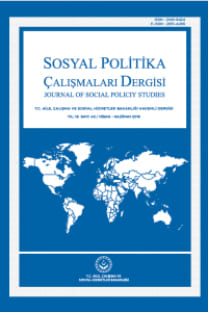Aile Yapısı Ergeni Mutlu Eder mi?
Ergen öznel iyi oluşu, aile yapısı
Can Family Structure of Adolescents Make Happy Adolescents?
Adolescents subjective well being, family structure,
___
- Andrews F.M. & Withey, S,B. (1976). Social ındicators of well-being. New York: Plenu Press
- Aycan, Z., Eskin, M. (2005). Relative contributions of childcare, spousal support, and
- organizational support in reducing work-family conlict for men and women: The case of Turkey. Sex Roles, 53 (7/8): 453-471.
- Bjorklund, D.F. (2000). Children thinking. USA: Wads- worth Press.
- Kagıtçıbası, Çigdem. (2000). Kültürel psikoloji ve kül- tür bağlamında insan ve aile. İstanbul: Evrim Yayınevi.2. Baskı.
- Köker, S. (1991). Normal ve sorunlu ergenlerin yaşam doyumu düzeyinin karşılaştırılması. Yayınlanmamış Yüksek Lisans Tezi. A.Ü. Sosyal Bilimler Enstitüsü. Ankara.
- Nalbant, A.(1993). 15-22 yaşları arasında bulunan is- lahevindeki, gözetim altındaki ve suç işlememiş gençlerin benlik saygısı ve yaşam doyumu düzeylerinin karşılaştırılması. Yayınlanmamış Yüksek Lisans Tezi. A.Ü. Sağlık Bilimleri En- stitüsü. Ankara.
- Markus, H., & Kitayama, S. (1991). Culture and the self: Implications for cognition, emotion, and motiva- tion. Psychological Review, 98, 224-253.
- McCullough, G., Huebner, S., & Laughlin, J.E. (2002). Life events, self concept, and adolescent’s posi- tive subjective well-being. Psychology in the School, Vol. 3: 281-290.
- Mcknight C.G, Huebner E.S., & Suldo, S. (2002). Rela- tionships among stressful life events, tempera- ment, problem behaviour, and global life satisfac- tion in adolescents. Psychology in the Schools, Vol. 39 (6), 677-687.
- Minuchin, S., Fishman, C. H. (1981). Family therapy techniques. Cambridge,n Massachusetts, And London, England: Harvard University Press.
- Myers, D. & Deiner, E. (1995). Who is happy. American Psychological Society, 6, 1,1-19.
- Park, N.(2004). The role of subjective well-being in posi- tive youth development. The Annals of American Acedemy of Political and Social Science. 591,1, 25-39.
- Pesseschkian, N. (1987). Positive psychoherapy: Theory and practise of new method. New York: Springer.
- Rask, K. Kurki,P.A.,&Paavilainen, E.(2003). Adoles- cent subjective well-being and family dynamics. Scand J.Caring Sci,17,129-138. Earlbaum
- Yorulmaz, A. & Eryılmaz, A..(2006). Ergen öznel iyi oluşunun özsaygı ve iyimserlik eğilimi ile ilişkisinin incelenmesi. Ulusal 14. Psikoloji Kon- gresi, Hacettepe Üniversitesi, Ankara, Türkiye, 6-8 Eylül.
- Zınn, M.B. Ve D.S.Eıtzen. (1990). Diversity in families. New York: Harper Collins. Kitabevi.
- ISSN: 2148-9424
- Yayın Aralığı: Yılda 4 Sayı
- Başlangıç: 2012
- Yayıncı: Aile,Çalışma ve Sosyal Hizmetler Bakanlığı
Güneydoğu Anadolu Bölgesi İllerinde Bölge İçi ve Dışı Göç Eğilimleri
Doç. Dr. Rüstem ERKAN, Arş. Gör. Deniz AYDIN
Yrd. Doç. Dr. Nurcan YABANCI, Prof. Dr. Gülden PEKCAN
Aile Yapısı Ergeni Mutlu Eder mi?
Sosyal Hizmette Sürdürülebilir Kalkınma Anlayışı: Kavramsal Analiz
Cinsel Suça Yönelen Çocukların Karakteristikleri ve Tedavi Programları
Doç. Dr. Özlem CANKURTARAN ÖNTAŞ
Yetişkinlere Yönelik Su Kullanımı Anketi’nin Geliştirilmesi
Eylem YILDIZ FEVZİOĞLU, Ercan AKPINAR, Gül ÜNAL ÇOBAN, Evren CAPELLARO, Ömer ERGİN
Velilerin Matematik Eğitimine Yönelik İlgileri, Tutumları ve Destekleri
Yrd. Doç. Dr. Tamer KUTLUCA, Yrd. Doç. Dr. Mehmet AYDIN
Kadınların Gebelik, Doğum ve Yenidoğan Bakımına İlişkin Geleneksel İnanç ve Uygulamaları
Öğr. Gör. Ayşe KOYUN, Canan ÇAMUROĞLU, Gülçin KORKMAZ, Nergis MENTEŞE, Fatma OCAK
